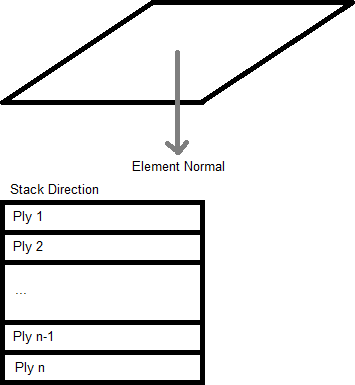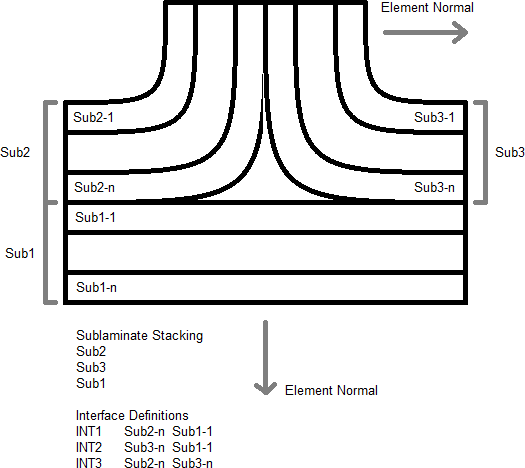Laminate entities are used to define laminates, which make up a laminated structure by defining the stacking sequence of ply entities that make up the laminated structure. There are three types of laminates which can be defined: ply laminates, sublaminates, and interface laminates.
Ply laminates are used to define laminates which make up flat or slightly curved laminated structures. Ply laminates stack ply entities. The stack direction for the plies of a ply laminate is in the direction of the element's normal.

Sublaminates are very similar to ply laminates in that they also stack ply entities. However, they define only a portion of a laminate rather than a complete laminate structure. The stack direction for the plies of a sublaminate is defined by an interface definition within an associated interface laminate. However, the ply order defined within a sublaminate must remain in the defined order. An interface definition of an interface laminate defines which ply of the sublaminate is on “top” and which is on the “bottom” relative to the elements normal.

Interface laminates are used to define laminates which make up complex laminated structures that “wrap around” corners. Interface laminates stack sublaminates. The stack direction for the sublaminates of an interface laminate is in the direction of the element's normal. The exact stacking sequence of the plies of the sublaminates is defined by the interface definitions within an interface laminate. An interface definition defines which “surface” plies of two sublaminates touch, or interface, with each other. Each sublaminate stacked within an interface laminate must have at least one interface definition.

Laminates have an active and export state. The active and export states of laminate entities can be controlled using the Entity State browser.
| • | The active state of a laminate controls the listing of the laminate in the Model browser and any of its views. If a laminate entity is active, then it is listed in the Model browser and any of its views. If a laminate entity is inactive, then it is not listed in the Model browser or any of its views. |
| • | The export state of a laminate entity controls whether or not that laminate is exported when the custom export option is utilized. The all export option is not affected by the export state of a laminate. |
| • | Laminates can be ‘realized’ using the right mouse button functionality in the Model browser. This will convert a ply based model into a zone based model. A ‘template’ property must be assigned to all elements referred to through the ply and laminate entities before. Then the realization algorithm creates as many properties as needed (as a copy from the template property) to represent the ply/laminate definition. Each region of the model with a unique set of layers will get its own property. |
The data names associated with laminates can be found in the data names section of the HyperMesh Reference Guide.
OptiStruct STACK cards are represented in HyperMesh as a laminate entity. Laminate entities are created and edited using the laminate create and edit dialogs from the Model browser. Laminates control the stacking sequence of a set of defined plies. Laminate realization as described above can be used in the OptiStruct interface to convert a ply based model into a zone based model. In this case the export state of all ply related entities (PCOMPP property, PLY and STACK) will be set so that they are not exported. To generate PCOMPG properties representing the ply and laminate definition, a PCOMPP card has to be defined and assigned to the elements involved in the composites definition before the realization is started.
|
Laminate entities are created and edited using the Laminate Create and Edit dialogs from the Model browser. Laminates control the stacking sequence of a set of defined plies. If a laminate is realized, HyperMesh creates as many composite properties as needed to represent the ply and laminate based definition. A ‘template’ composites property (SHELL SECTION or SHELL GENERAL SECTION) has to be assigned all concerned elements first, as the algorithm derives the new properties from the same. The laminate name ends up in the LAYUP parameter of the Abaqus property.
|
Laminate entities are created and edited using the Laminate Create and Edit dialogs from the Model browser. Laminates control the stacking sequence of a set of defined plies. If a laminate is realized, HyperMesh creates as many composite properties (PCOMPG) as needed to represent the ply and laminate based definition. A ‘template’ composites property PCOMPP has to previously be assigned all concerned elements. The PCOMPP property is not exported. |